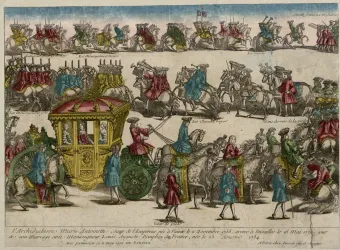There had been no attempts to harm the sacred body of the king since the attack by Ravaillac in 1610. But in 1757, as Louis XV was leaving the Palace, a man rushed towards him and stabbed him in the side. His name was Robert-François Damiens.

Assassination attempt on King Louis XV by Damiens, 1757 5 January 1757
On 5 January 1757 a coach was waiting for king Louis XV in the covered passageway leading to the North Parterre from the Royal Courtyard. At around 6 pm the monarch descended the interior staircase and crossed the Guard Room, accompanied by the Dauphin, the Captain of the King’s Guards, the Grand and Petit Equerries and the Colonel of the Swiss Guards. It was dark. Just as he left the room, which was lit by torches, a man rushed past his bodyguards and struck him forcibly in the side. The culprit was seized, thanks to the fact he had kept his hat on, which he ought to have taken off before the king.
The king, believing he had been punched or elbowed, grasped his side with his hand; but his hand came away covered in blood. The penknife had penetrated between the fourth and fifth ribs, causing a long but shallow wound. Bleeding badly, the king was carried to his bedchamber in a state of shock and eventually fainted. When he regained consciousness, he believed he was going to die and called for a priest. He entrusted the kingdom to the Dauphin and asked the queen for forgiveness for the trouble he had caused her.
ANECDOTE
His fate was similar to that of Ravaillac: he was subjected to various forms of torture, then quartered and burned. Damiens was guilty of the ultimate crime: the capital offence of “parricide against the person of the king”!
The would-be assassin was a servant named Damiens, aged 42 and born in Arras. He had previously worked in the service of several councillors in the Parlement, who too frequently excoriated the king and the Marquise de Pompadour. Easily influenced, Damiens had taken to heart all of these criticisms and turned fanatical. After being arrested he was tortured to find out if he had any accomplices, but he revealed nothing. Taken to the Conciergerie, as Ravaillac had been, he was tried from 12 February to 26 March and executed two days later. His gruesome fate was similar to that of Ravaillac: he was subjected to various forms of torture, then drawn and quartered by horses, and his torso was burned and ground to ashes. Even though he had failed at it, Damiens was found guilty of the ultimate crime: the capital offence of “parricide against the person of the king”.
The king knew from the outset that the attack was an isolated case but, although he recovered from his wound after eight days, he was nonetheless perturbed. The attack had its after-effects. In the face of a widespread public unease, the king decided to change his attitude. He intended to regain the confidence of his subjects, stop seeing his mistresses, and prepare the Dauphin for his succession. These wise resolutions were short-lived, however, and Mme de Pompadour, after a brief spell of worry, soon returned and was the centre of the king’s affections once again until his death in 1764. Louis XV, ironically known as “the Beloved”, died in the end an unpopular king…











